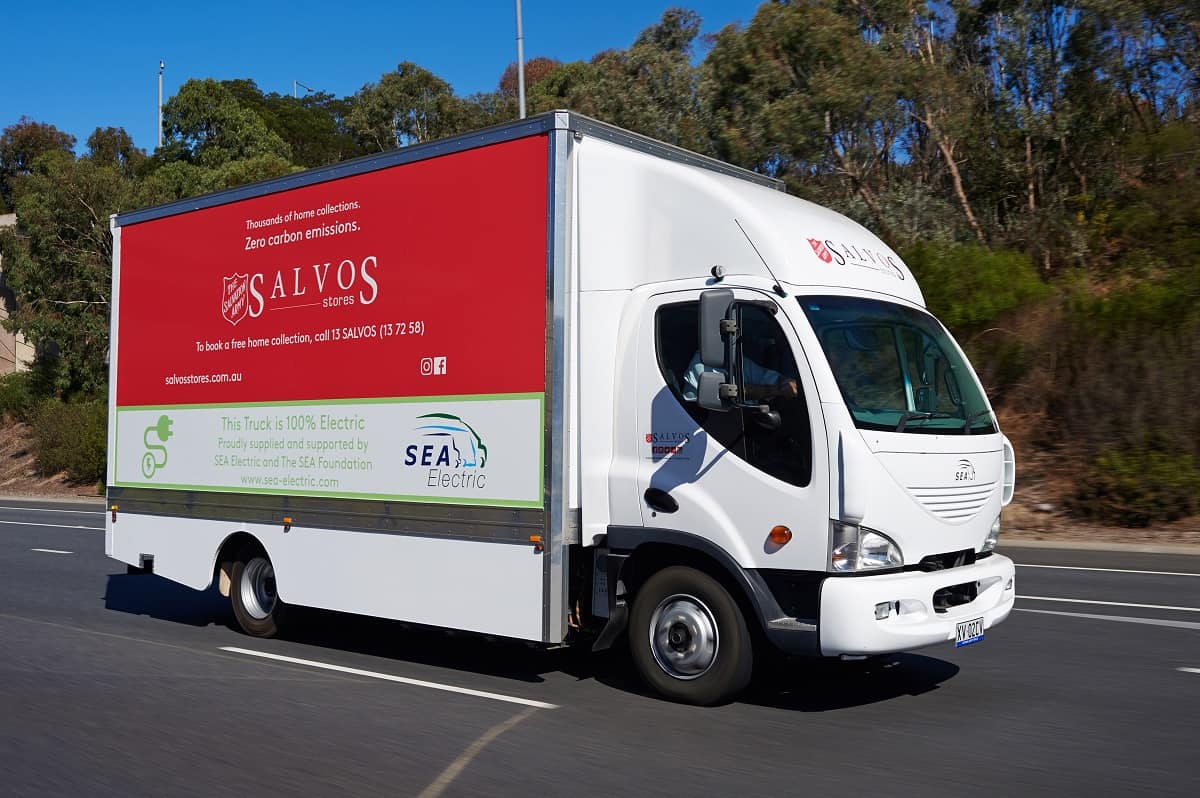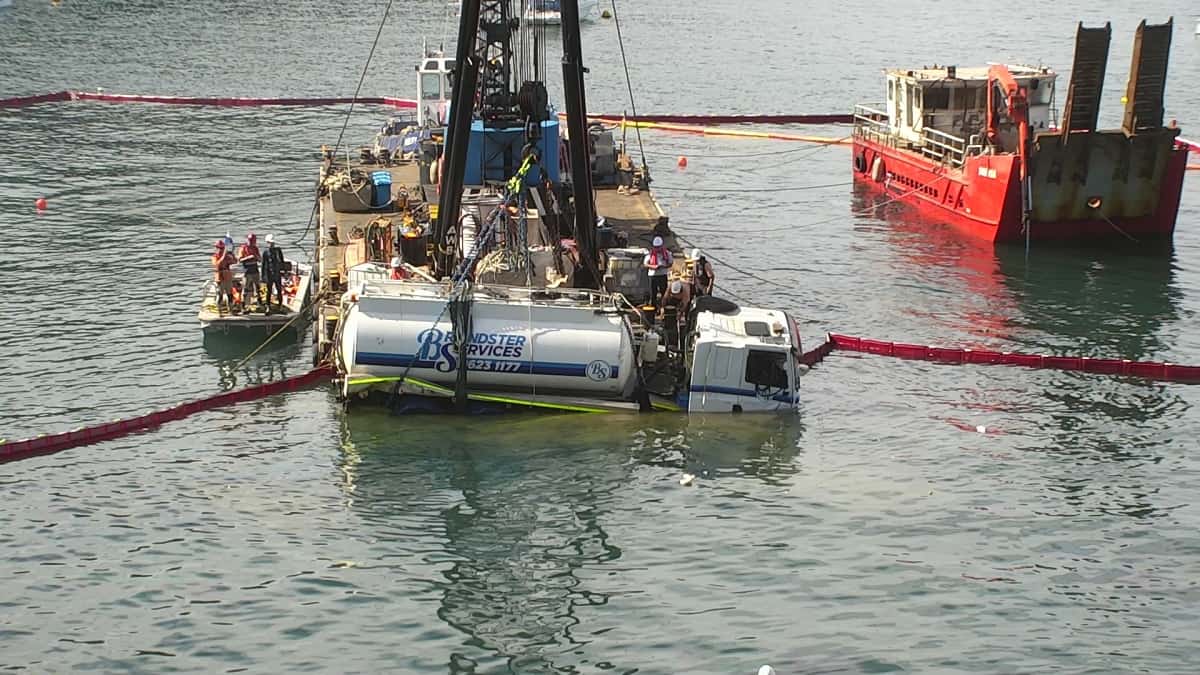In Australia this week: new truck sales this year in Australia are slumping when compared to last year; transport company PAGE buys Allalong to exploit the Sydney to Tasmania freight market; seaport says millions of truck movements can be eliminated; electric truck is donated to charity; stink-trunk gets un-sunk.
New truck and van sales slump in Australia
Sales in Australia’s new truck market is in free fall. Sales of vehicles with a gross mass over 3,500kg (7,716.2 pounds) are down by 14.3 percent at the end of August this year when compared to the same period last year.
“Sales in all truck and heavy van categories were down on August 2018 results and the heavy vehicle market is now showing clear signs of slowing in 2019, with month on month lower sales recorded,” reads a statement from the Truck Industry Council, which represents commercial vehicle manufacturers in Australia.
Heavy Duty Truck sales were down by 21.6 percent August this year compared to August last year. The year-to-date trend is down 7.9 percent this year when compared to the same timeframe in 2018. The Medium Duty Truck Segment has “struggled since the start of 2019” and the year-to-date sales volumes are seven percent down on the year before. New Light Duty Truck sales are down by 9.4 percent in the year to date when compared to the prior corresponding period.
Tony McMullan, CEO of Truck Industry Council, said, “the August result continues the trend that has been building over the past few months. Economic conditions have generally slowed globally and in Australia. We now see that trend reflected in new truck and heavy van sales. Given the slowing of sales over the past three, to four months, it would now seem unlikely that we will witness a turnaround in new truck sales over the next four months to year end. Hence it is likely that the market will finish down on the record result that was posted in 2018.”
However, McMullan pointed out that, despite the downturn this year compared to last year, 2019 may well finish above the second-highest market, which was in 2007. That would potentially make “2019 the second best year on record for new heavy vehicle sales in Australia,” McMullan said.
A new PAGE for Sydney trucking company
PAGE Tasmanian Freight has bought Sydney-headquartered Allalong Tasmanian Searoads for an undisclosed sum.
Allalong has depots in Sydney, Melbourne, Launceston and Hobart.
Commenting on the acquisition, Geoff Page, the Chairman of PAGE Transport, said that the purpose of the deal was to “ gain a footprint into the Sydney to Tasmania market.”
The purchase also helps speed the growth plans of PAGE Tasmanian Freight, the company said.
It appears that Raj Singh, Chief Executive Officer of PAGE Tasmanian Freight, believes he spotted a niche in the Australian market. According to a statement published by PAGE, Singh saw a potential to capitalise on a gap in the industry and to enhance trade options between mainland Australia and the island of Tasmania. Singh indicated that there are few large freight companies offering a direct Sydney to Tasmania service.
“Expanding into this market will enable us to provide customers with additional services… between Sydney and Tasmania,” Singh said.
Millions of truck movements could be eliminated
About 2.4 million truck movements could be eliminated from regional roads around the Port of Brisbane in northern Australia if the port is linked to a mega-rail line that is being built into the interior of the country.
The Inland Rail is a 1,100 mile railway between the city of Melbourne in the south of Australia to the city of Brisbane in the north of the country. The purpose of the project is to help move freight around Australia’s eastern regions, bypassing the congested railways around Sydney.
A series of intermodal terminals along the Inland Rail route will allow rural Australian businesses to move agricultural freight to and from ports more cheaply and more quickly. The project should be completed by 2025 at a total cost of A$10.9 billion (US$7.5 billion).
Somewhat bizarrely, given that the purpose of the project is to connect the agricultural produce generating regions to world markets, the Inland Rail won’t actually connect to the Port of Brisbane. It will actually end at the Acacia Ridge terminal in the south west of the city, about 16.5 miles short of the port. Agricultural export freight would have to be de-trained at Acacia Ridge and loaded onto trucks for hauling through the city to the port.
The Port of Brisbane has just released economic modelling showing the benefits of connecting the Inland Rail to the port. The effects would include:
- removal of 2.4 million truck movements from regional roads each year
- A$155 million (US$106.6 million) in reduced road maintenance costs
- A$195 million (US$134.1 million) in reduced congestion costs
- Savings of A$130 (US$89.40) per twenty foot equivalent shipping container
Electric truck donated to charity
Specialist vehicle assembler and converter SEA Electric has donated an electric rigid-body cab-over truck to charity retailer Salvos Stores.
SEA Electric is a Melbourne-based company that converts traditional commercial trucks to electric power and which also supplies its own-brand electric vans and trucks using third-party glider vehicles.
The electric truck donated to Salvos Stores is said to be the first electric vehicle deployed in the fleet of a charity retailer in Australia. The electric truck does not emit carbon during operation and will help Salvos Stores reduce emissions of carbon dioxide by two metric tonnes a year. A metric tonne is equivalent to 2,204.6 U.S. pounds a year.
“The donation of this electric vehicle will help to further Salvo’s Stores commitment to being a more accessible pillar of the community, providing greater support to community by being able to facilitate some last minute collections,” SEA Electric said in a statement.
Salvos Stores said it is focusing on minimizing its impact on the planet. “Introducing the first electric vehicle into its fleet of trucks is a step to a more sustainable future and a new way of operating a large logistics network,” the joint SEA Electric and Salvos statement reads.

Cab-over, rigid-body and… winged monkeys?
If a vandal were to graffiti and spray paint your old rigid-body truck then most truck drivers and truck operators would be… displeased. But how would you feel if the vandal was the famous artist Banksy? And how would you feel if that act of vandalism increased the value of your truck by a few million dollars?
Well, that’s the situation with a 1988 Volvo FL6 truck that was hand painted and decorated by graffiti artist Banksy back in 2000. The artwork “Turbo Zone Truck (Laugh Now But One Day We’ll Be In Charge)” was up for sale by auction on September 14, 2019, by auctioneer Bonhams. Signed twice, accompanied by a certificate of authenticity from Banksy and acquired directly from the artist in 2000, it is forecast that the truck will reach a few million at auction.
According to the auctioneer’s catalogue, the artwork is described as a “uniquely hand-painted 17-ton truck [that] is a mobile testament to Banksy’s longstanding, breakthrough vandalism of art’s old-hat approach to painting on canvas and paintings in galleries. Taking the vehicle of the laborer, the workman and the blue-collar employee as his blank canvas, the present motorcar and work of art revels in Banksy’s raw and unfiltered wit; a masterclass of the artist’s satirical humour and impressive dexterity with spray-paint… Awash with images of anarchy and unruly subjects, Turbo Zone Truck (Laugh Now But One Day We’ll Be in Charge) wonderfully illustrates a variety of Banksy’s most prominent and sought-after characters, from the winged monkeys and SWAT teams”.
Banksy was asked to paint the truck in southern Spain ahead of a warehouse party to celebrate the millennium celebrations in 2000. It took the artist two weeks to completely finish painting the truck which was then taken on tour around Europe and South America with Turbozone Circus.
Stink truck gets un-sunk
Regular readers of Down Under Trucking will be aware of the sunken truck filled with about 2,642 gallons of sewage. Hauling sewage is big business with consultants IBISWorld estimating that sewage and drainage services generate revenues of about A$10.1 billion a year.
The stink-truck has been sunk for about 23 days off the eastern coast of the state of New South Wales. However, the local authorities have completed a salvage operation and have removed the truck from the waters off Great Mackerel Beach.
Transport for NSW Acting Director NSW Maritime Mark Hutchings said: “It was a good result for everyone – the biggest risk was for there to be some kind of breach of the sewage holding tanks. A well-crafted salvage plan with appropriate marine pollution response equipment and trained specialist staff on site has ensured the optimum result. The salvage team appointed by the barge owner and insurer, overseen by NSW Maritime, has done a great job. Slow and steady has won the race.”
The truck was being carried by a commercial barge in late August when then barge-truck combo sank.









Grey wood
Thanks for sharing this! We are truck removal Newcastle that buys all types of trucks whether running or not.
James Bushell
Re Inland Rail and its purpose – it is actually not for agricultural goods but intercapital goods. The agricultural freight benefits are somewhat of a ‘byproduct’. So the port links were not part of the original scope if you come at it from that perspective.
Re Truck market – when was the last time we saw such a slump?